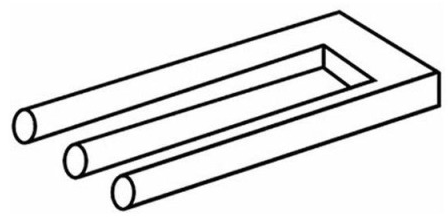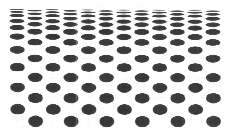
1. What is the difference between sensation and perception?
2. Why study perception?
3. What is the difference between distal and proximal stimuli?
4. What is the problem of underdetermination?
5. Describe the following theoretical approaches to perception:
- structuralism
- Gestalt psychology
- constructivism
- ecological approach
- information-processing approach
- computational approach
- neurophysiological approach
6. What are some common themes in perception?
• can be defined in terms of _______ processes, like receptor activation and neural firing
• or in terms of ______ activity that mediates between sensation and awareness, interpreting what our senses tell us
- process of encoding energy or chemicals in the environment in terms of neural signals
- a basic experience elicited by a simple stimulus
- more concerned with your own physical experience
e.g., feeling of warmth on your skin
- organization and interpretation of neural signals, making them meaningful
- more complex conscious experiences produced by integrating sensations
- more concerned with identifying the stimulus
e.g., you see a glowing red stove element, producing heat you feel; you know it is 50 cm away, and it can burn you
1. for _____________: basic research
- to determine how underlying mechanisms function
- first step in understanding _________
e.g., mind/body relationship
- to know why the world looks, sounds, feels, tastes, and smells the way it does
e.g., why does orange juice taste bad after brushing your teeth?
2. to solve _________ problems: applied research
- to develop solutions for sensorily ________
e.g., Braille, glasses
- to understand the practical applications of illusions (________: a misinterpretation of sensory stimuli; as a result, perception does not match reality)
e.g., dazzle camouflage: high-contrast geometric patterns painted on warships that cause misjudgments about their speed, distance, and heading
- to produce ___________ for the world
e.g., stereo sound, surround sound
- to produce substitutes for the ________
e.g., robotic vision
- the world is three-dimensional
- the image on our retina is 2-D
- yet we think of the world in 3-D!
- this problem is called __________________
______ stimulus: the object in the world
e.g., an apple; a finger poking your arm; a vibrating string
________ stimulus: the pattern of energy or chemicals impinging on our receptors
e.g., pattern of photons on your retina; kinetic energy on your skin; sound energy hitting your eardrum
How do we go from an underdetermined proximal stimulus produced by a distal stimulus, and arrive at a correct perception of the world?
e.g., 2-D retinal image of apple → percept of 3-D apple
- there are many possible _______________ of the proximal stimulus

- how do we decide which one is correct?
- different answers to this question define different schools of thought in the study of perception
_____________
- goals: analyze conscious processes into basic “________”; specify how elements become connected
- Wilhelm Wundt (b.1832-d.1920): first psychology lab, University of Leipzig (1879)
- Edward Titchener (b.1867-d.1927) relied on _____________: analysis of one’s own conscious experience
- problem: perception is holistic, not elemental
Gestalt psychology
- Gestalt means “form” or “configuration”
- opposed _____________: decomposition to elementary components loses information
- was a holistic approach that emphasized consciousness
- goal: specify the ____________ among stimuli:
o
o o
- motto: “the whole is different than the sum of its parts”
- founded by Max Wertheimer (b.1880-d.1943)
Constructivism
- perceiving is an ______ process, affected by our knowledge and experience
- we must _________ ambiguous information provided by the environment
e.g., “Devil’s Trident”:

- goal: determine how existing knowledge influences perception
- Hermann von Helmholtz (b.1821-d.1894), Irvin Rock (b.1922-d.1995), Richard Gregory (b.1923-d.2010)
__________ Approach
- we should study perception in natural settings
- enough information is available in the environment to make mental calculations ___________
- J.J. Gibson (b.1904-d.1979): proposed information is ________ picked up from the environment
e.g., via texture gradients:

Information-Processing Approach
- describes the flow of incoming sensory information via hypothesized internal processes
- information is analyzed to decode and interpret it
- does not differentiate between sensation, perception, and cognition
- highly influential in cognitive psychology
_____________ Approach
- assumes the mind is an information processor that receives, stores, retrieves, transforms, and transmits information
- David Marr (b.1945-d.1980): defined vision mathematically, using computer simulations
- information processing has three levels of analysis:
1. _____________ Theory
What is the system doing?
e.g., What does it mean to “see” something?
2. ______________ and _________
What is the percept? How is it being processed?
e.g., Do the eyes function like cameras? Is there an “inner screen” in our heads?
3. Hardware ______________
What physical “machinery” does this?
e.g., What neural circuits allow us to see?
Neurophysiological Approach
- based on ____________: understanding of behaviour via studying the underlying biological processes
- important for sensation; less for perception
- Doctrine of Specific Nerve Energies (Johannes Müller, 1837):
• percept depends on which specific _____ has been activated
e.g., seeing light when the optic nerve is stimulated
• different sensory nerves senses go to different brain regions
• Evolution: What is the ____________ advantage of a particular sense?
• Coding/Representation: How is a stimulus encoded in our sensory neurons and represented in the brain?
• __________: How are different aspects of a stimulus analyzed?
• Integration: How are these different aspects recombined to form a whole percept?
• Processing: How do top-down (existing _________ structures) and bottom-up (incoming sensory data) processes interact?
• ____________: How well does our perceptual experience represent objective reality?